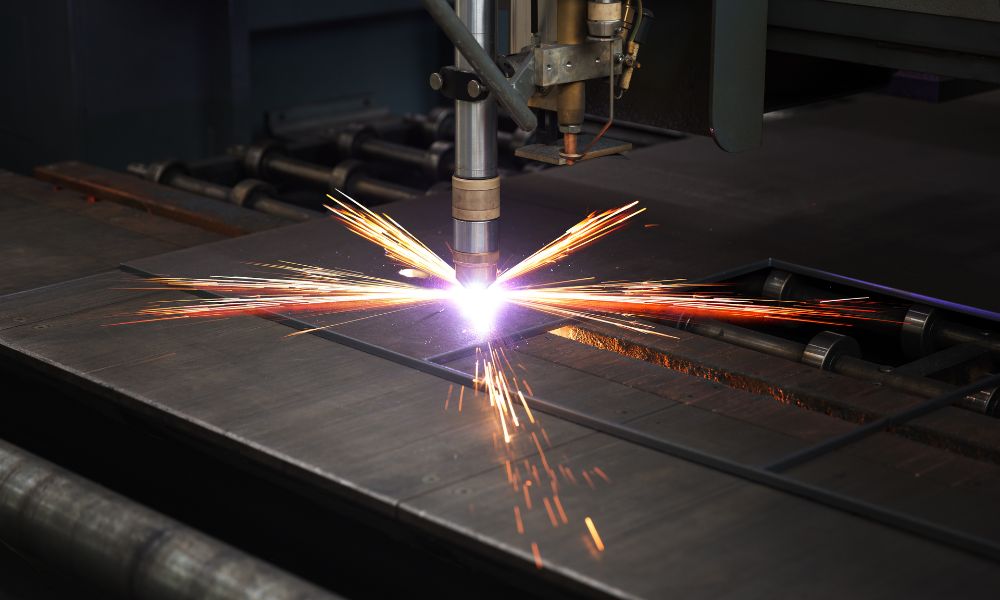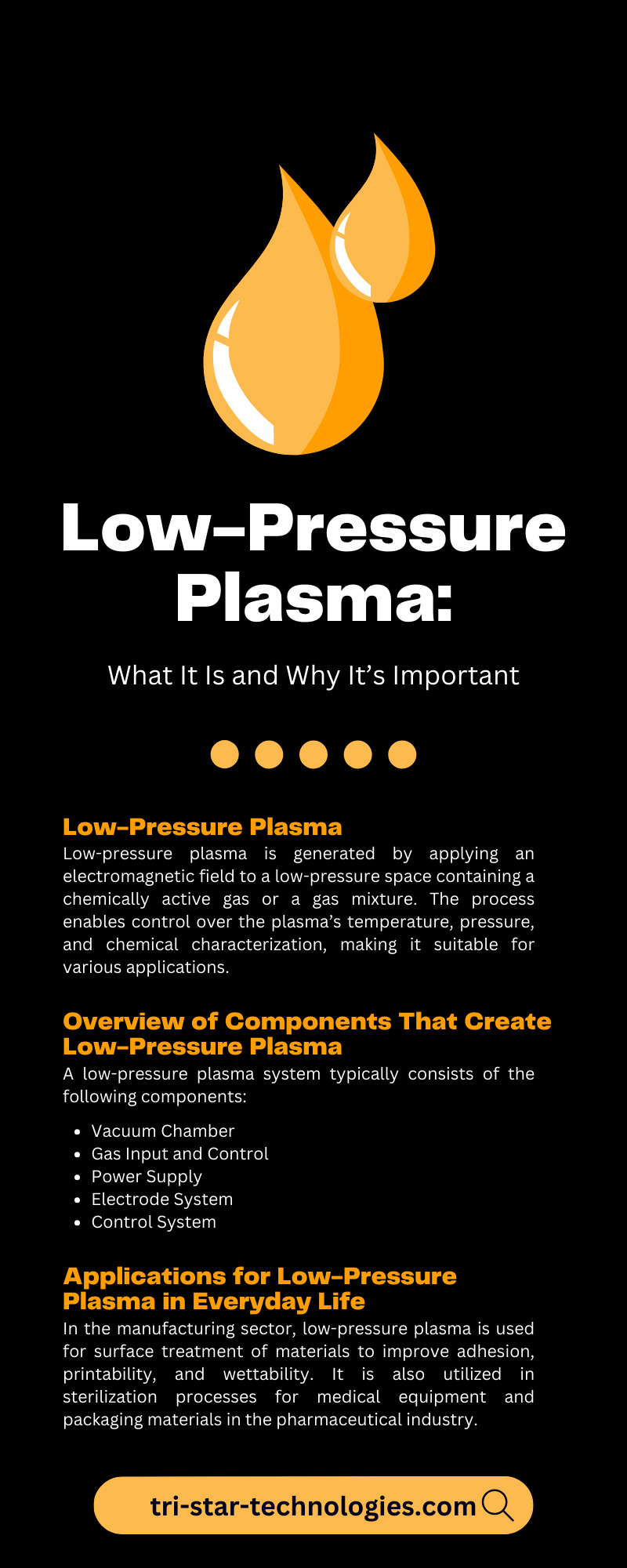Low-Pressure Plasma: What It Is and Why It’s Important

Low-pressure plasma has become a game-changer in various industries, especially in engineering, pharmaceuticals, and manufacturing. If you’re looking to learn more about low-pressure plasma, we have you covered. Our beginner’s guide to low-pressure plasma will explain what it is, why it’s important, and more.
The Basics of Plasma Physics
Plasma, considered the fourth state of matter, is a highly ionized gas containing ions, free electrons, and neutral particles. It is formed when energy from heat, electricity, or other sources causes gas atoms to partially ionize, generating charged particles. Plasma physics studies plasma behavior, which consists of complex electromagnetic properties and diverse applications.
Low-Pressure Plasma
Low-pressure plasma is generated by applying an electromagnetic field to a low-pressure space containing a chemically active gas or a gas mixture. The process enables control over the plasma’s temperature, pressure, and chemical characterization, making it suitable for various applications.
Overview of Components That Create Low-Pressure Plasma
A low-pressure plasma system typically consists of the following components:
Vacuum Chamber
A vacuum chamber is a sealed container that creates and maintains the low-pressure conditions necessary for generating plasma. It is typically made of a durable material, such as stainless steel, and is equipped with valves and ports for gas input, pressure control, and sample introduction.
Gas Input and Control
The gas input and control system is responsible for introducing the desired gas or gas mixture into the vacuum chamber and regulating its flow to maintain a stable pressure. This component is crucial in determining the chemical composition of the plasma and its overall behavior.
Power Supply
The power supply is a critical component of generating low-pressure plasma, providing the necessary energy to create and sustain the plasma. It typically consists of high voltage sources, such as radio frequency generators or direct current power supplies, that deliver electric fields to ionize gas molecules and generate charged particles.
Electrode System
The electrode system also plays a vital role, providing the surface for electrons to be emitted and accelerated toward the gas molecules, initiating ionization. It is crucial to have well-designed electrodes that can withstand high temperatures and chemical reactions caused by the plasma. Electrode geometry can also affect the uniformity and stability of the generated plasma.
Control System
The control system regulates and monitors various parameters of the low-pressure plasma system, such as gas flow, pressure, power input, and temperature. It ensures that the desired conditions are maintained to produce a stable and efficient plasma process. Advanced control systems also offer real-time data analysis and feedback, allowing for precise control over the plasma generation.
Applications for Low-Pressure Plasma in Everyday Life
Low-pressure plasma has a wide range of applications in everyday life, making it an essential technology in various industries. In the manufacturing sector, low-pressure plasma is used for surface treatment of materials to improve adhesion, printability, and wettability. It is also utilized in sterilization processes for medical equipment and packaging materials in the pharmaceutical industry. Additionally, low-pressure plasma has shown promising results in air and water purification, as well as the production of nanomaterials for use in electronics, energy storage, and biomedical applications.
Technologies Using Low-Pressure Plasma and Their Applications
Some low-pressure plasma technologies include plasma etching, surface modification, and deposition. Plasma etching is used in micro- and nanofabrication to remove material from a surface with high precision, making it essential in producing semiconductors and electronic devices. Surface modification involves changing the properties of a material’s surface, leading to improved adhesion, lubrication, and biocompatibility.
What Makes Low-Pressure Plasma Different From Other Plasma Sources
Low-pressure plasma can maintain a consistent reaction environment with minimal temperature fluctuations, ensuring uniform application results. Additionally, its unique chemical and physical properties can be tailored to achieve a wide range of desirable surface modifications.
Advantages of Low-Pressure Plasma Over Other Forms of Technology
Consider the following benefits of choosing low-pressure plasma over other technologies.
Precision Cutting and Welding
Low-pressure plasma offers precise control over energy distribution, making it ideal for cutting and welding delicate materials like thin metals and plastics. Its low thermal impact minimizes the risk of damage to surrounding areas, resulting in cleaner cuts and stronger welds.
Environmentally Friendly
Unlike traditional chemical methods, low-pressure plasma does not produce harmful by-products or waste, making it a more environmentally friendly option. It also consumes less energy, making it a more sustainable choice for industrial processes.
Multi-Purpose Applications
Low-pressure plasma’s ability to modify surface properties and generate diverse chemical reactions makes it a highly versatile technology. It can be used for various applications, from surface treatment to sterilization, making it an essential tool in many industries. Its adaptability and efficiency make it a cost-effective solution for different processes, reducing the need for multiple technologies or methods.
Increased Speed and Efficiency
Low-pressure plasma can significantly increase the speed and efficiency of industrial processes, reducing production time and costs. Its ability to perform multiple functions in one step also helps streamline production and improve overall efficiency.
Innovations Using Low-Pressure Plasma
Over the years, low-pressure plasma technology has evolved to include advanced features like remote plasma sources, hollow cathode electrodes, and atmospheric pressure plasma systems. These developments have expanded its range of applications and made it more accessible and user-friendly.
The Future of Low-Pressure Plasma Technology
With its broad range of applications and continuous advancements, low-pressure plasma technology is poised for further growth in the future. Advancements in process control, materials science, and computer simulation will likely lead to more sophisticated, efficient, and diverse uses for this cutting-edge technology.
Tips for Choosing a Low-Pressure Plasma Provider
When seeking a low-pressure plasma provider, it is crucial to research their experience, expertise, and reputation in the industry. Look for providers with comprehensive support and a track record of successful implementations in your desired application. Additionally, consider the availability of spare parts and servicing options to ensure smooth operations and minimal downtime. It is also essential to inquire about the provider’s customer support and training programs to make sure you have the necessary knowledge and resources for optimal use of the technology.
Consider Tri-Star Technologies
Thank you for taking the time to learn about low-pressure plasma, from what it is to why it’s important. As a leading provider of industrial marking systems, Tri-Star Technologies offers comprehensive low-pressure plasma solutions that can be tailored to your specific needs. With our experience, expertise, and commitment to customer support, we are confident in our ability to deliver high-quality results for your applications. Contact us today to see how we can help you incorporate low-pressure plasma technology into your processes and stay ahead of the curve.



